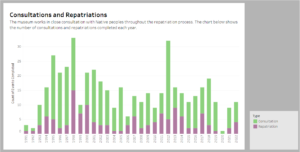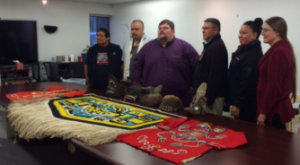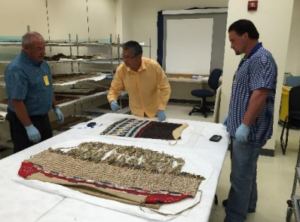
Procession during the National Museum of the American Indians’ repatriation of remains to Cuzco, Peru. 1996. NMAI.
There are many instances of repatriation associated with the Smithsonian and 20 museums, which include locations in DC, New York City, and Virginia. Recently, in May of 2022, they’ve begun adopting an “ethical returns” policy which aims to return objects and materials acquired in unethical ways by modern standards (Ludel, 2022). They plan to implement this policy in all of their museums, not just the ones that currently have ongoing repatriation efforts and activities. One of these museums is the National Museum of the American Indian.
The National Museum of the American Indian, with locations in Washington DC, and New York, NY, opened in 1989 their current mission is to foster understanding of Native peoples. This institution’s repatriation policy falls under the National Museum of the American Indian Act which requires the Smithsonian to return, upon request, materials and remains to Native groups. When requests are received, they have multiple consultations with the groups to determine what items might belong to the tribe, as well as if any of the remains are associated with them.
Though the Smithsonian is primarily federally funded, it is able and willing to give time and attention to groups and tribes that may not be federally recognized. A large problem for some groups in getting their ancestors back is a lack of governmental recognition. Under the NMAI Act (National Museum of the American Indian Act) and NAGPRA (the Native American Graves Protection and Repatriation Act), the only groups with legal standing to start repatriations are those who are federally recognized (Thornton 2020). Quite a few tribes in the United States are not federally recognized as the process for this is long, time-consuming, and expensive, and there is no guarantee that a group will become federally recognized even if they complete it. A good example of this exclusion is the Lumbee Tribe in North Carolina. Though they are state recognized and federally recognized as American Indians, they are not federally recognized as a tribe and do not have the benefits that come with this (United States. Congress. House. Committee on Natural Resources 2009). Many museums, cultural institutions, and universities would not work with the Lumbee Tribe on restoring their ancestors or artifacts due to this lack of federal recognition. This is similar to the University of Edinburgh and its willingness to repatriate to Taiwan even though the UK government does not formally recognize them.

Graph of Consultations and Repatriations. NMAI.
Many repatriation activities have been completed over the years as can be seen by this graph. The green bar shows the number of consultations had with tribes in any year. These consultations allow groups access to their ancestors, funerary objects, religious objects, and other important cultural heritage. They also allow researchers at the NMAI the ability to establish “cultural affiliation” for those interested in getting ancestors or materials repatriated. This cultural affiliation is important on multiple levels, first, it is important to make sure people and objects are returning where they belong, instead of possibly having to do another repatriation down the line. Second, it is important legally, bills like NAGPRA require a certain amount of certainty to be met before repatriations are legally required. Some cultural institutions will not even consider repatriation until the guidelines are met to the highest standard. Finally, it is important in understanding the ancestors in a museum’s care. Similar to the Skull Collection, sometimes identifying information can get lost, destroyed, or never existed, to begin with. This can make it difficult to know a lot about the ancestors without the help of the tribes. If the tribes can provide documentation, DNA (in situations where it is deemed appropriate), or oral histories, it could make the process go smoother, faster, and more be more beneficial for everyone involved.
The purple bar shows the number of repatriations done in any year. This is just the repatriation itself, it does not show how many catalog numbers were returned though this information is available elsewhere on the site. Many of the repatriations the NMAI does are mixed (human remains and cultural objects) or contain multiple items. In the example down below, seven items were repatriated at once. This is similar to the Skull Collection, in the instance of the Veda skulls nine were returned in one ceremony.
One of the repatriations highlighted in a 2015 report was the return of seven objects to multiple clans in Alaska. These objects included helmets, a headdress, a shirt, and a blanket (Smithsonian Institution 2015, 13). Ceremonies or send-offs are often part of this repatriation process, allowing groups to feel closer to their ancestors. Another case highlighted in the same report is a consultation with the Tolowa Dee-ni’ Nation. This consultation allowed group members to interact with their ancestral heritage and have a more physical connection with these objects (Smithsonian Institution 2015, 12).

Repatriation Photo from 2015. NMAI.

Consultation Photo from 2015. NMAI.
The process by which the NMAI repatriates remains and items is particularly relevant to our current brief as the Smithsonian and the National Museum of the American Indian have many things that our museum lacks.
- Funding: The NMAI has a large amount of funding from a variety of different sources which allows them to accomplish these activities with relative ease. They have multiple members of staff whose sole job is to facilitate these activities.
- Visibility: Tribes know that there is a chance ancestral remains and/or sacred objects may be located at the Smithsonian. This is not the case for some groups whose ancestors may be in the skull collection. Many groups, especially in the United States will have no idea that there is a chance their ancestors are at a university in Scotland.
- Time: The NMAI has many people who work in the museum and with their collection, with people who work with specific aspects of the collection. The Skull Collection is one of the multiple collections that two people are in charge of, which comes with many limitations for their time.
Bibliography
Ludel, W. (2022, May 4). Smithsonian adopts new ‘ethical returns policy’ to handle artefacts with problematic histories. The Art Newspaper – International art news and events. Retrieved October 10, 2022, from https://www.theartnewspaper.com/2022/05/04/smithsonian-new-ethical-returns-policy
The National Museum of the American Indian. (n.d.). Quechua Procession. Repatriation. Retrieved October 10, 2022, from https://americanindian.si.edu/sites/1/files/images/repatriation/main/Quechua-Procession-283×190.jpg.
Repatriation dashboard. National Museum of the American Indian. (n.d.). Retrieved October 10, 2022, from https://americanindian.si.edu/explore/repatriation/repatriation-dashboard
Smithsonian. (n.d.). Vision; Mission. National Museum of the American Indian. Retrieved October 10, 2022, from https://americanindian.si.edu/about/vision-mission
Smithsonian Institution. 2015. “Annual Report of the Repatriation Activities of the Smithsonian Institution.” National Museum of the American Indian. https://americanindian.si.edu/sites/1/files/pdf/repatriation/NMAI-RepatriationAnnualReport-2015.pdf.
Thornton, Russell. 2020. “Repatriation and the Negotiation of Identity.” In The Routledge Companion to Indigenous Repatriation: Return, Reconcile, Renew, edited by Cressida Fforde, C. Timothy McKeown, and Honor Keeler, 889–901. Routledge. https://www.taylorfrancis.com/books/edit/10.4324/9780203730966/routledge-companion-indigenous-repatriation-honor-keeler-timothy-mckeown-cressida-fforde.
United States. Congress. House. Committee on Natural Resources. 2009. Lumbee Recognition Act: Report Together with Additional and Dissenting Views (to Accompany H.R. 31) (Including Cost Estimate of the Congressional Budget Office). Google Books. U.S. Government Printing Office. https://www.google.co.uk/books/edition/Lumbee_Recognition_Act/wN93ibn97XkC?hl=en&gbpv=0.
(https://americanindian.si.edu/sites/1/files/pdf/repatriation/NMAI-RepatriationAnnualReport-2015.pdf)
(https://americanindian.si.edu/sites/1/files/pdf/repatriation/NMAI-RepatriationAnnualReport-2015.pdf)


Leave a Reply